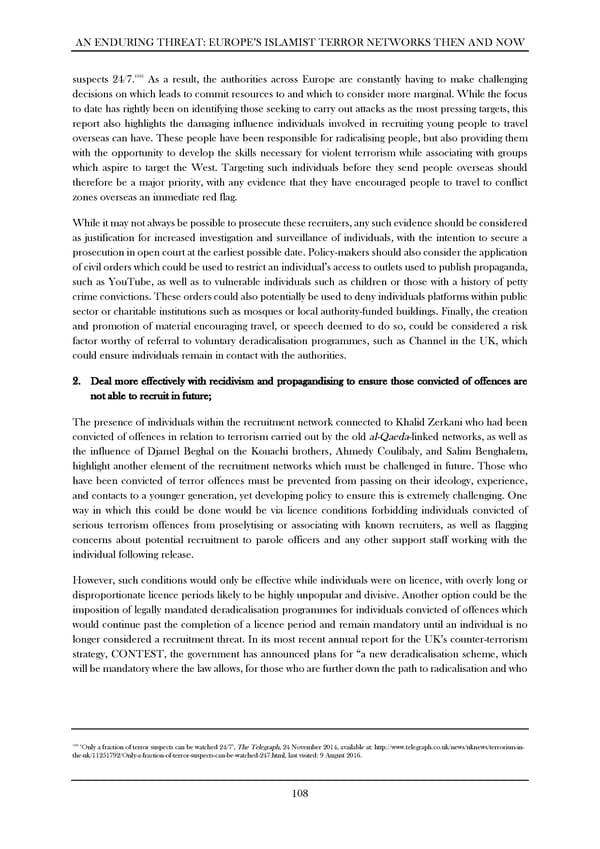AN ENDURING THREAT: EUROPE’S ISLAMIST TERROR NETWORKS THEN AND NOW 1355 suspects 24/7. As a result, the authorities across Europe are constantly having to make challenging decisions on which leads to commit resources to and which to consider more marginal. While the focus to date has rightly been on identifying those seeking to carry out attacks as the most pressing targets, this report also highlights the damaging influence individuals involved in recruiting young people to travel overseas can have. These people have been responsible for radicalising people, but also providing them with the opportunity to develop the skills necessary for violent terrorism while associating with groups which aspire to target the West. Targeting such individuals before they send people overseas should therefore be a major priority, with any evidence that they have encouraged people to travel to conflict zones overseas an immediate red flag. While it may not always be possible to prosecute these recruiters, any such evidence should be considered as justification for increased investigation and surveillance of individuals, with the intention to secure a prosecution in open court at the earliest possible date. Policy-makers should also consider the application of civil orders which could be used to restrict an individual’s access to outlets used to publish propaganda, such as YouTube, as well as to vulnerable individuals such as children or those with a history of petty crime convictions. These orders could also potentially be used to deny individuals platforms within public sector or charitable institutions such as mosques or local authority-funded buildings. Finally, the creation and promotion of material encouraging travel, or speech deemed to do so, could be considered a risk factor worthy of referral to voluntary deradicalisation programmes, such as Channel in the UK, which could ensure individuals remain in contact with the authorities. 2. Deal more effectively with recidivism and propagandising to ensure those convicted of offences are ! not able to recruit in future; The presence of individuals within the recruitment network connected to Khalid Zerkani who had been convicted of offences in relation to terrorism carried out by the old al-Qaeda-linked networks, as well as the influence of Djamel Beghal on the Kouachi brothers, Ahmedy Coulibaly, and Salim Benghalem, highlight another element of the recruitment networks which must be challenged in future. Those who have been convicted of terror offences must be prevented from passing on their ideology, experience, and contacts to a younger generation, yet developing policy to ensure this is extremely challenging. One way in which this could be done would be via licence conditions forbidding individuals convicted of serious terrorism offences from proselytising or associating with known recruiters, as well as flagging concerns about potential recruitment to parole officers and any other support staff working with the individual following release. However, such conditions would only be effective while individuals were on licence, with overly long or disproportionate licence periods likely to be highly unpopular and divisive. Another option could be the imposition of legally mandated deradicalisation programmes for individuals convicted of offences which would continue past the completion of a licence period and remain mandatory until an individual is no longer considered a recruitment threat. In its most recent annual report for the UK’s counter-terrorism strategy, CONTEST, the government has announced plans for “a new deradicalisation scheme, which will be mandatory where the law allows, for those who are further down the path to radicalisation and who ! ! 1355 ‘Only a fraction of terror suspects can be watched 24/7’, The Telegraph, 24 November 2014, available at: http://www.telegraph.co.uk/news/uknews/terrorism-in- the-uk/11251792/Only-a-fraction-of-terror-suspects-can-be-watched-247.html, last visited: 9 August 2016. ! ! 108 !
 An Enduring Threat: Europe’s Islamist Terror Networks Then and Now Page 113 Page 115
An Enduring Threat: Europe’s Islamist Terror Networks Then and Now Page 113 Page 115